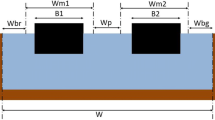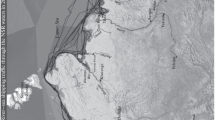Abstract
In response to an increased reliance on bigger, Neopanamax-sized vessels for shipping, the Panama Canal has been expanded. Whilst the way that vessels transit the newly expanded canal has stayed the same, maneuvering operations have changed. As a result, transit times have been affected. In accordance with the size and cargo of vessels, canal navigation rules restrict how access channels (Culebra Cut, Gatún Lake, and seaways) and new locks (Cocolí and Agua Clara) are used. Larger sized, Neopanamax vessels will benefit most from the expanded canal. Since the canal opened on 26 June 2016, data on transit times have been gathered. With these data, a thorough statistical analysis should be carried out. The most influential variables on overall time in transit (TET), such as pilot skill and Culebra Cut or Gatun Lake transit times, are identified. Formulae based on multivariate linear regression can be extracted that will make it possible to establish a conductive methodology for estimating the transit time of a Neopanamax vessel. Taking into account the results of the statistical analysis, a proposal is included for improving Neopanamax traffic management, with views to reduce the TET, from a transit policy point of view. This is the first work in scientific literature that analyzes in detail, from qualitative and statistical approaches, the total time in transit through the set of navigable routes and locks that compose the new expanded Panama Canal.

Source: author’s own, using Panama Canal Authority (PCA) data

Source: [20]

Source: author’s own

Source: author’s own







Source: author’s own
Similar content being viewed by others
Abbreviations
- ANOVA:
-
Analysis of variance
- CC:
-
Clear cut
- CCDL:
-
Clear-cut daylight locks
- CCTM:
-
Maritime traffic control center
- CL:
-
Control limit
- DLCC:
-
Daylight cut clear cut
- LCL:
-
Lower control limit
- LNG:
-
Liquefied natural gas
- LOA:
-
Overall length
- LPG:
-
Liquefied petroleum gas
- MARS:
-
Multivariate adaptive regression splines
- MT:
-
Maritime transport
- PC:
-
Panama canal
- PCA:
-
Panama canal authority
- RMSE:
-
Root-mean-squared error
- SVM:
-
Support vector machines
- TET:
-
Transit time
- UCL:
-
Upper control limit
- USL:
-
Upper specification limit
References
Huebner G (1915) Economic aspects of the Panama Canal. Am Econ Rev 5(4):816
Laxe FG, Seoane MJF, Montes CP (2012) Maritime degree, centrality and vulnerability: port hierarchies and emerging areas in containerized transport (2008–2010). J Transp Geogr 24:33
Montes CP, Seoane MJF, Laxe FG (2012) General cargo and containership emergent routes: a complex networks description. Transp Policy 24:126
Karsten CV, Pisinger D, Ropke S, Brouer BD (2015) The time constrained multi-commodity network flow problem and its application to liner shipping network design. Transp Res Part E Log Transp Rev 76:122
Ducruet C (2016) The polarization of global container flows by interoceanic canals: geographic coverage and network vulnerability. Marit Policy Manag 43(2):242
Notteboom T, Rodrique JP (2011) Challenges to and challengers of the Suez Canal. Port Technol Int Rev Adv Technol Port Terminal World Wide N Y 51:14
Martin J, Martin S, Pettit S (2015) Container ship size and the implications on port call workload. Int J Ship Transp Log 7(5):553
Pagano A, Wang G, Sánchez O, Ungo R, Tapiero E (2016) The impact of the Panama Canal expansion on Panama’s maritime cluster. Marit Policy Manag 43(2):164
P. Panama Canal Authority. Informe anual. http://www.pancanal.com. Accessed July 2016
P. Panama Canal Authority. Plan maestro 2005–2025 (2006). http://www.pancanal.com. Accessed July 2016
Carral L, Tarrío-Saavedra J, Naya S, Bogle J, Sabonge R (2017) Effect of inaugurating the third set of locks in the Panama Canal on Vessel Size, Manoeuvring and lockage time. J Navig 70(6):1205
Rabelo L, Cruz L, Bhide S, Joledo O, Pastrana J, Xanthopoulos P (2014) In: Proceedings of the 2014 winter simulation conference (IEEE Press), pp 910–921
Rabelo L, Marin M, Xanthopoulos P, Lennox CA, Coiduras P, Campos B, Andrade L, Collins R, Atencio E, Pitty D (2012) Preliminary hybrid modeling of the Panama Canal: operations and salinity diffusion. Model Simul Eng 2012:9
Franzese LAG, Abdenur LO, Botter RC, Starks D, Cano AR (2004) In: Proceedings of the 2004 Winter simulation conference, vol. 2 (IEEE), pp 1835–1838
Marin M, Zhu Y, Andrade LA, Atencio E, Boya C, Mendizabal C (2010) In: Proceedings of the winter simulation conference (winter simulation conference), pp 2023–2033
Alvarez AHR, Solis D, Cano SAR, Sala-Diakanda S (2006) In: Proceedings of the 38th conference on winter simulation (winter simulation conference), pp 660–666
Cho A, Bray WD, Worthington WE, Padelford NJ, Gordon BL (2016) Panama Canal. Encyclopædia britannica. Encyclopædia britannica, Inc. https://www.britannica.com/topic/Panama-Canal. Accessed July 2016
Nix E (2014) Fascinating Facts About the Panama Canal. http://www.history.com/news/7-fascinating-facts-about-the-panama-canal.History.com. Accessed July 2016
Panama Canal Authority (2006) Proposal for the expansion of the Panama Canal: third set of locks project. Panama Canal Authority. http://ufdcimages.uflib.ufl.edu/AA/00/01/07/50/00001/acp-expansion-proposal.pdf. Accessed July 2016
P. Panama Canal Authority. Simulación y Capacidad Operativa. Simulación y capacidad operativa. http://www.pancanal.com. Accessed July 2016
Maldonado AC (2015) Efectos de la ampliación del canal de Panamá sobre el comercio y el tráfico marítimo internacional. Repositorio de la Universidad Politécnica de Valencia
Carral L, Naya S, Álvarez Feal C, LamasPardo M, Tarrío-Saavedra J (2017) Estimating the traction factor and designing the deck gear for the anchor handling tug. Proc Inst Mech Eng Part M J Eng Marit Environ 231(2):600
Meyer D, Dimitriadou E, Hornik K, Weingessel A, Leisch F (2017) e1071: Misc Functions of the Department of Statistics, Probability Theory Group (Formerly: E1071), TU Wien. https://CRAN.R-project.org/package=e1071. R package version 1.6-8. Accessed May 2019
Kuhn M et al (2008) Caret package. J Stat Softw 28(5):1
Grömping U (2006) Relative importance for linear regression in R: the package relaimpo. J Stat Softw 17(1):1
Maindonald J, Braun W (2015) DAAG: data analysis and graphics data and functions [Software]. http://CRAN.R-project.org/package=DAAG (R package version 1.22). Accessed May 2019
Flores M (2016) qcr: quality control review. https://CRAN.R-project.org/package=qcr. R package version 1.0. Accessed May 2019
Sou T, Nagashima K (2016) RcmdrPlugin.KMggplot2: r commander plug-in for data visualization with ’ggplot2’. https://CRAN.R-project.org/package=RcmdrPlugin.KMggplot2. R package version 0.2-4. Accessed May 2019
Montgomery DC (2007) Introduction to statistical quality control. Wiley, New York
Barbeito I, Zaragoza S, Tarrío-Saavedra J, Naya S (2017) Assessing thermal comfort and energy efficiency in buildings by statistical quality control for autocorrelated data. Appl Energy 190:1
Yi JH (2016) Laboratory tests on local damage detection for jacket-type offshore structures using optical FBG sensors based on statistical approaches. Ocean Eng 124:94
Benetazzo F, Ippoliti G, Longhi S, Raspa P (2015) Advanced control for fault-tolerant dynamic positioning of an offshore supply vessel. Ocean Eng 106:472
Woodall WH (1985) The statistical design of quality control charts. Statistician 34:155
Box GE, Hunter JS, Hunter WG (2005) Statistics for experimenters: design, innovation, and discovery, vol 2. Wiley, New York
Tarrío-Saavedra J, González CG, Naya S, López-Beceiro J, Ponton A (2017) Statistical modeling applied to deformation–relaxation processes in a composite biopolymer network induced by magnetic field. PLoS One 12(1):e0169866
Sheather SJ, Jones MC (1991) A reliable data-based bandwidth selection method for kernel density estimation. J R Stat Soc Ser B (Methodol) 53(3):683
Rodriguez M (2011) El esquema de practicaje en el canal de panama. monografía—seminario internacional: Canal de panamá: El reto de la ampliación de la vía interoceánica o cómo diseñar, construir y gestionar una de las obras de ingeniería más grandes del mundo. https://www.fundacionareces.tv/watch/canal_de_panama?as=4f0ca68694a05fc458070000. Accessed May 2019
Carral L, Couce JC, Tarrío-Saavedra J, Formoso JAF (2019) Net winch design in trawlers, influence of vessel size and fishing ground. Proc Inst Mech Eng Part M J Eng Marit Environ 233(1):108
Carral L, Alvarez-Feal JC, Tarrio-Saavedra J, Guerreiro MJR, Fraguela JÁ (2018) Social interest in developing a green modular artificial reef structure in concrete for the ecosystems of the Galician rías. J Clean Product 172:1881
Chen J, Wang Y, Song M, Zhao R (2017) Analyzing the decoupling relationship between marine economic growth and marine pollution in China. Ocean Eng 137:1
Du P, Ouahsine A, Toan K, Sergent P (2017) Simulation of ship maneuvering in a confined waterway using a nonlinear model based on optimization techniques. Ocean Eng 142:194
Sui C, Song E, Stapersma D, Ding Y (2017) Mean value modelling of diesel engine combustion based on parameterized finite stage cylinder process. Ocean Eng 136:218
Tarrío-Saavedra J, López-Beceiro J, Naya S, Francisco-Fernández M, Artiaga R (2014) Simulation study for generalized logistic function in thermal data modeling. J Thermal Anal Calorimetr 118(2):1253
Lindeman RH, Merenda P, Gold R (1980) Introduction to bivariate and multivariate analysis. Scott Foresman, Glenview
Canty AJ (2002) Resampling methods in R: the boot package. R News 2(3):2
Fan RE, Chen PH, Lin CJ (2005) Working set selection using second order information for training support vector machines. J Mach Learn Res 6(Dec):1889
Mafi S, Amirinia G (2017) Forecasting hurricane wave height in Gulf of Mexico using soft computing methods. Ocean Eng 146:352
Friedman JH (1991) Multivariate adaptive regression splines. Ann Stat 19(1):1
Mansson JT, Lutzhoft M, Brooks B (2017) Joint activity in the maritime traffic system: perceptions of ship masters, maritime pilots, tug masters, and vessel traffic service operators. J Navigat 70(3):547
Acknowledgements
The authors would like to thank the Autoridad del Canal de Panamá and the Universidad Internacional Marítima de Panamá their valuable help.
Funding
This research/work has been supported by MINECO Grants MTM2014-52876- R and MTM2017-82724-R, and by the Xunta de Galicia (Grupos de Referencia Competitiva ED431C-2016- 015 and Centro Singular de Investigación de Galicia ED431G/01), all of them through the ERDF.
Author information
Authors and Affiliations
Corresponding author
Additional information
Publisher's Note
Springer Nature remains neutral with regard to jurisdictional claims in published maps and institutional affiliations.
About this article
Cite this article
Carral, L., Tarrío-Saavedra, J., Álvarez-Feal, JC. et al. Modeling and forecasting of Neopanamax vessel transit time for traffic management in the Panama Canal. J Mar Sci Technol 25, 379–396 (2020). https://doi.org/10.1007/s00773-019-00650-3
Received:
Accepted:
Published:
Issue Date:
DOI: https://doi.org/10.1007/s00773-019-00650-3




